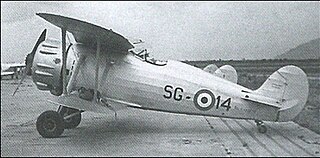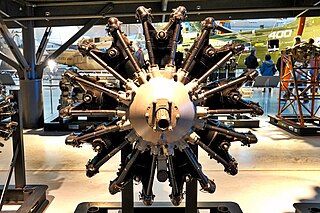Related Research Articles

The Mil Mi-2 is a small, lightly armed turbine-powered transport helicopter that could also provide close air support when armed with 57 mm rockets and a 23 mm cannon.
RS-82 and RS-132 were unguided rockets used by Soviet military aircraft in World War II.
The Breda Ba.88 Lince ("Lynx") was a ground-attack aircraft used by the Italian Regia Aeronautica during World War II. Its streamlined design and retractable undercarriage were advanced for the time, and after its debut in 1937 the aircraft established several world speed records. However, when military equipment was installed on production examples, problems of instability developed and the aeroplane's general performance deteriorated. Eventually its operational career was cut short, and the remaining Ba.88 airframes were used as fixed installations on airfields to mislead enemy reconnaissance. It represented, perhaps, the most remarkable failure of any operational aircraft to see service in World War II.
The Armstrong Siddeley Lynx is a British seven-cylinder aero engine developed by Armstrong Siddeley. Testing began in 1920 and 6,000 had been produced by 1939. In Italy Alfa Romeo built a 200 horsepower (150 kW) licensed version of this engine named the Alfa Romeo Lynx.

The RM-70 multiple rocket launcher is a Czechoslovak army version and heavier variant of the BM-21 Grad multiple rocket launcher, providing enhanced performance over its parent area-saturation rocket artillery system that was introduced in 1971.
The PT Mi-Ba-II is a large Bakelite cased Czechoslovakian anti-tank blast mine. The mine is unusual in that it has two plunger fuses instead of a pressure plate. The plunger fuses give the mine resistance to overpressure, also the plastic body makes it difficult to detect.
The PT Mi-K is a Czechoslovakian metal-cased anti-tank blast landmine. The mine uses a metal grid instead a pressure plate, this gives it resistance to overpressure. The mine is no longer produced, but is found in Afghanistan, Cambodia, Eritrea, Namibia, Nicaragua and the Western Sahara.
The PT Mi-Ba is a circular Bakelite cased Czechoslovakian minimum metal anti-tank blast mine. The mine entered service with the Czech and Slovakian armies in the 1950s and is now obsolete and no longer in service. The mine is conventional in layout with a central pressure plate, and doughnut-shaped main charge around a booster charge and RO-7-II fuze. The mine's fuze is the only component that contains any metal, and this is limited to a spring, the striker pin, and the detonator capsule.
The Na-Mi-Ba is a Czechoslovakian minimum metal bakelite cased anti-tank blast mine. The mine uses a horizontal lever fuze, with a very low operating pressure that breaks open a glass capsule containing acid, which initiates a flash composition. The mine has a small main charge, and is normally used as the initiator for larger charges. The low operating pressure means that the mine could be used as an anti-personnel mine.
The PT Mi-U is a circular Czech anti-tank mine with a Misznay Schardin effect warhead. It can be used with a conventional pressure fuze or a tilt rod fuze.
The PT Mi-P is a large Czechoslovakian anti-tank mine. The mine is a large hemisphere, with a carrying handle and an RO-9 attachment for a tilt rod on one side. It uses a large shaped charge warhead that uses a five millimeter thick steel liner, and can penetrate up to 150 millimeters of armour. The mine was in service with the armies of the Czech Republic and Slovakia, but is now obsolete.

The Consolidated O-17 Courier was an observation and training aircraft used by the United States National Guard.

The IMAM Ro.41 was an Italian light biplane fighter aircraft, serving in the Regia Aeronautica in the 1930s-1940s, mainly as a trainer.

The IMAM Ro.57 was an Italian twin-engined, single-seat monoplane fighter of the Regia Aeronautica. Based on a 1939 design by Giovanni Galasso the aircraft did not enter production until 1943.

The Lycoming R-680 is a nine-cylinder air-cooled radial engine, the first aero engine produced by Lycoming. The engine was produced in two types, the E and B series; both are essentially the same. The B4E was available in a trainer version with a front exhaust collector "ring" for use without cylinder air baffles. R-680 received Approved Type Certificate No. 42 on 4 Feb 1930.

The Ro-100-class submarine was a group of medium-sized coastal submarines built for the Imperial Japanese Navy (IJN) during World War II. The IJN official designation for this class was Ko type submarine or Senshō type submarine. They are also known as Type KS submarine. The type name was shortened to Sensuikan Ko-gata.

The IMAM Ro.58 was an Italian twin-engined, two-seat monoplane heavy fighter and attack aircraft, a development of the IMAM Ro.57. First flown in May 1942, it was considered a general improvement over its predecessor, mainly due to the substitution of higher power Daimler-Benz DB 601 engines for the Fiat A.74 engines used on the Ro.57. Initially it had many problems and during the maiden flight only the proficiency of the test pilot, Adriano Mantelli, saved the plane.
Ro-102 was an Imperial Japanese Navy Ro-100-class submarine. Completed and commissioned in November 1942, she served in World War II, operating in the Solomon Islands, Rabaul, and New Guinea areas. She disappeared in May 1943 during her third war patrol.
The Myanmar Directorate of Defence Industries (D.I.) is a part of the Tatmadaw. D.I. produces various types of military equipment throughout the country. It produced more than 70 products for the Myanmar Army, the Myanmar Navy and the Myanmar Air Force as of 2008. The main products include automatic rifles, machine guns, sub-machine guns, anti-aircraft guns, mortars and artillery ammunition, UAVs and anti-aircraft ammunition, tanks, armoured vehicles and anti-tank ammunition, bombs, grenades, anti-tank mines, anti-personnel mines such as the M14 pyrotechnics, commercial explosives and commercial products, and rockets and so forth.
References
- Jane's Mines and Mine Clearance 2005-2006
- PT Mi-Ba-III mine at ORDATA